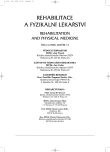Shoulder Girdle in the Regiment of Quadrupedal Locomotion
RAMENNÍ PLETENEC V REŽIMU KVADRUPEDÁLNÍ LOKOMOCE
Ramenní pletenec je do lokomoce člověka přímo zapojen v procesu posturálně pohybové ontogeneze přibližně do jednoho roku věku dítěte. Jeho lokomoční funkce je poté střídána funkcí manipulace a zajištění úchopu. Využití lokomoční funkce pletence ramenního v dalším životě nabízí široké spektrum sportovních aktivit. Studie přináší ukázku zapojení některých svalů v průběhu specifické sportovní lokomoce, která je zajišťována přes pletenec ramenní. Vybrané svaly jsou součástmi záběrových řetězců nebo zajišťují nastavení lopatky, jež rozhodujícím způsobem ovlivňuje centraci ramenního kloubu v procesu lokomoce.
Klíčová slova:
lidská lokomoce, elektromyografie, zkřížený lokomoční vzor
Authors:
M. Vystrčilová 2; B. Kračmar 1,2; P. Novotný 2
Authors‘ workplace:
Klinika komplexní rehabilitace MONADA, Praha
1; FTVS UK, Praha
2
Published in:
Rehabil. fyz. Lék., 13, 2006, No. 2, pp. 92-98.
Category:
Original Papers
Overview
Shoulder griddle is a part of human locomotion in the process of postural movement ontogenesis. Its locomotion function is then alternated by the manipulation function and grip realization. The locomotion spectrum during a sport activity allows the shoulder griddle to use the locomotion function. The study brings an example of some muscle involvement during the locomotion realized by the shoulder griddle. These selected muscles are parts of interaction chains or realize the scapula position, which is a decisive fact for central position of shoulder griddle when realizing human locomotion.
Key words:
human locomotion, electromyography, crossed locomotion pattern.
Labels
Physiotherapist, university degree Rehabilitation Sports medicineArticle was published in
Rehabilitation & Physical Medicine

2006 Issue 2
- Hope Awakens with Early Diagnosis of Parkinson's Disease Based on Skin Odor
- Deep stimulation of the globus pallidus improved clinical symptoms in a patient with refractory parkinsonism and genetic mutation
Most read in this issue
- Relationship betweem Breathing Movements and Posture
- Disorders of Cervicothoracic Junction and Distant Symptoms
- New Knowledge about Structural Prerequisites in Coordination of the Diaphram Function and Belly Muscles
- Shoulder Girdle in the Regiment of Quadrupedal Locomotion
